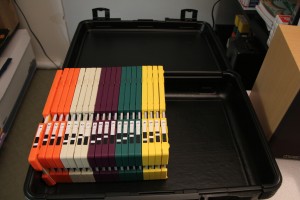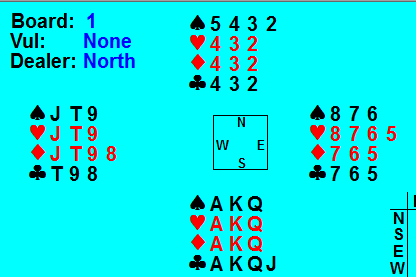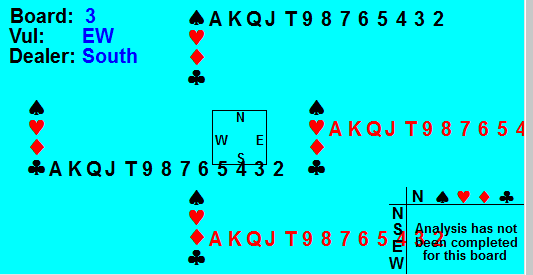
Here are five tables worth of hands ready for my next class. Each table gets boards one through four, in a distinctive board color.
Last month I took a leap and purchased a bridge hand dealing machine. The PlayBridgeDealer4 is very popular with bridge clubs and tournament managers for preparing pre-dealt hands and duplicating them across many sections of a tournament.
Some day down the road I may find myself directing bridge games for a local club. When I do, I’ll use the machine to prepare randomly shuffled hands before the game, and provide hand records with analysis afterward.
Meanwhile, I can put the machine to excellent use for preparing hands for my bridge classes.
The Dealer4 comes with some excellent Windows-based software for generating random deals, doing hand analysis, and printing hand records. It also works very effectively for constructing bridge hands manually. I’ve prepared hands for the first three class series from the ACBL curriculum, the club, diamond, and heart series classes. In fact, you can download each series as a zip archive of .PBN files from whiteoaks.com here.

ACBL offers these card decks that allow students to manually sort class hands during class. It’s confusing for some, frustrating for others, but foolproof for the teacher. (Photo from BaronBarclay.com)
Before I had the Dealer4, I was a great fan of the special cards prepared by the ACBL specifically for these classes. The backs of the cards are marked in a way that lets the students sort out the hands manually during class. It’s (mostly) foolproof, and requires no more preparation on my part than dropping a deck of these cards on each table of students.
I can’t really say that having the dealing machine has made class prep “easier” in that regard. I’m not saving time in class preparation.
But I am saving time during class itself. Sorting the cards is a common source of frustration for the students, and it eats up a lot of class time. When the sorts don’t always come out exactly right, it takes more time to correct the problem.
Plus this classroom card sorting exercise is not something that has the slightest bit of value later on in their bridge playing, either at home or the duplicate club.
So the benefit of pre-dealing the hands is for the classes. It means that I spend more time fretting and worrying. I’ve had nightmares where I show up for class with the wrong hands sorted into the boards, or a mix of hands in the wrong boards. I find that I just have to be more careful with class preparation. So far everything has come out perfectly, but I still have to spot-check my work.
So now that I could deal hands magically and reliably, I had to get a little playful with the process as well. What if I could provide pre-sorted hands for the students?
Having sorted hands is meaningless at the bridge club. When a hand is played once, it will no longer be sorted. In class though, it again saves time the students might have spent sorting their hand and laying them out double-dummy for study. It’s true that hand-sorting is a useful skill, but they have plenty of time to pick that up with their own shuffled decks.
If I start with a completely sorted deck of cards in the Dealer4, the hands that arrive in the pockets will be sorted as well. So the puzzle for me was how to use the Dealer4 to sort the decks before dealing them into four hands.
Sorting by suits is trivial, simply send all the spades to one hand, the hearts to another, and so on. But I wanted to sort the cards by rank as well.
I came up with a two-pass deal that gives me an approximate rank sort as well as a suit sort. For the first pass, I send all the lowest ranked cards to North, the next highest to East, next to West, and the highest-ranked to South. Here’s the deal I use:
That gives me a deck with all the low cards on the bottom, and the high cards on the top. Then I pass the deck through again for a sort by suit:
The result is a full deck that is sorted by suits, and approximately sorted by rank as well.
Since the Dealer4 needs to have two decks in the hopper, I work on two decks at a time to get this sort. So after four passes through the machine, I have two mostly-sorted decks of cards.
Then I use these sorted decks to populate my boards for class, and know that I’m the coolest bridge teacher in my zip code. 
Postscript: I now have a three-pass deal that returns fully sorted hands. I’ll write it up in a followup blog post. 
The card dealing machine is a fascinating bit of mechanical engineering, and I know you can’t resist seeing it in operation. So I made a little video (3:00 minutes) that shows how I feed decks into the machine for the pre-sort, then load boards into the machine to set up hands.



Hi,
I also bought a Dealer4 for teaching purposes. I actually have the Dealer4+. I also wanted to sort and I came up with the same 2-stage procedure as you. Now you say you have the ability to sort exactly in rank order in 3 passes. I would love to see that, because I did not think of one (although I did not spend very much time trying to conjure up an algorithm. I am a retired math teacher, so I will find your schema very interesting if you would share it with me.
ALSO, how did you get it to first sort and then deal, or did you first sort 12 decks, for example, then deal those same 12 decks?
Thanks for sharing.
Steve
I definitely need to write that up. I’ll put the pbn file on my download site.
Before setting up hands, I sort a bunch of decks, then feed the sorted decks to the machine for making the hands.
I added the three-pass full sort as a pbn file to my download page here: http://whiteoaks.com/dealer4-teaching/